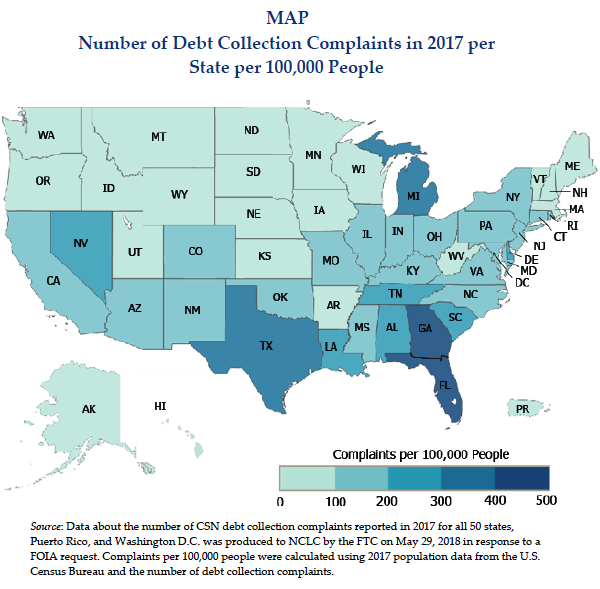Executive Summary
Every year the Federal Trade Commission (FTC) collects consumer complaints through its Consumer Sentinel Network (CSN). In 2017, there were 620,800 complaints about debt collection – making it the most common type of consumer complaint compiled in the FTC’s CSN Data Book. Yet, relatively little data about these debt collection complaints is published.
This National Consumer Law Center report analyzes complaints about debt collection practices collected by the FTC in 2017. It contains some information that has never been published, which was obtained through Freedom of Information Act (FOIA) requests.
Complaints can help regulators understand what types of problems consumers are experiencing with debt collectors and identify actors who may be violating the law. They can also identify the states and regions where consumers report more abusive debt collection practices, and help researchers identify factors that lead to these problems. Additionally, with the Consumer Financial Protection Bureau’s (CFPB) ongoing debt collection rulemaking, CSN complaint data offers another opportunity to learn about consumer experiences with debt collection.

Key Findings
- Consumers make hundreds of thousands of complaints about debt collection practices every year.
- Since 2015, debt collection complaints have been the most common type of consumer complaint reported in the CSN Data Book. From 2008 to 2014, it was the second most common type of complaint.
- Seven out of the ten states with the highest per capita number of debt collection complaints in 2017 are in the South, one is in the mid-Atlantic, one is in the Midwest, and one is in the West.
- Eight out of the ten states with the highest per capita number of debt collection complaints in 2017 had a higher percentage of residents with debts in collection reported on their credit reports than the 33% share for the nation as a whole.
- In 2017, top categories of reported law violations included:
- “Calls After Getting ‘Stop Calling’ Notice” (227,917 complaints),
- “Calls Repeatedly” (210,238 complaints),
- “Makes False Representation about Debt” (192,704 complaints),
- “Fails to Identify as Debt Collector” (84,364 complaints),
- “Tells Someone Else About Consumer’s Debt” (39,760 complaints), and
- “Falsely Threatens Illegal or Unintended Act” (31,519 complaints).
- Nationally, the top three recipients of debt collection complaints were Enhanced Recovery Associates, Portfolio Recovery Associates, and Credit One Bank – each receiving more than 10,000 consumer complaints in 2017.
Recommendations
The FTC should do more to make the debt collection complaint data that it collects annually in the CSN widely available by:
- Publishing all debt collection complaints and
- Reporting more information about debt collection complaints.
The FTC should also take steps to improve collection of CSN debt collection complaint data by:
- Standardizing data collection;
- Facilitating complaints via apps;
- Facilitating complaints by consumers with limited English proficiency; and
- Conducting outreach in communities that are underreporting.
The FTC and others should use the CSN debt collection complaint data to guide continued enforcement and strengthen consumer protections against abusive debt collection.
See all resources related to: Consumer Protection Regulation